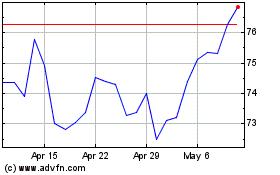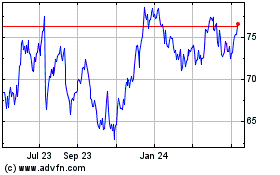Pension Funds DIY: State Street Report Points to Increasingly “Hands-On” Approach of Pension Funds Globally
November 10 2014 - 9:30AM
Business Wire
Pension funds globally say they intend to adopt a more proactive
approach to managing their assets, according to a new report by
State Street Corporation (NYSE: STT). “Pensions Funds DIY: A
Hands-On Future for Asset Owners,” highlights the key trends that
are reshaping how pension funds manage their investments operating
models and deliver long-term value to members. The report is based
on a research survey of more than 100 pension fund executives
conducted in conjunction with the Economist Intelligence Unit
(EIU).
Driving this change is the challenge of building a holistic view
of risk across a multi-asset portfolio while aggregating risk data
from multiple managers, aligning interests and managing costs.
“Pension funds’ desire to deliver strong investment returns to
their participants coupled with improved oversight and governance
and is leading to a need for more in-house accountability for asset
and risk management,” said Martin J. Sullivan, head of Asset Owner
sector solutions for North America, State Street. “However, this
undertaking requires pension funds to carefully evaluate how to
achieve a balance of in-house and external talent, tools and
technologies.”
Some key trends that emerged from the research
include:
- A majority of pension fund respondents
(81 percent) indicate they are exploring bringing more asset
management responsibilities in-house over the next three years.
This is due in part to cost concerns, with 29 percent indicating it
is a challenge for them to justify the fees of their asset
managers.
- As part of this shift, a majority of
pension funds (53 percent) are expecting to use more lower-cost
strategies to achieve desired investment outcomes, as well as
expanding the number of technology platforms and software solutions
they employ (43 percent).
- More than half (51 percent) of funds
place a high priority on strengthening their governance over the
next three years.
“While the largest and most sophisticated funds can handle most
aspects of multi-asset class portfolios in-house, the majority of
pension funds will need to make a choice about where to be a
specialist and when a sub-contractor is needed,” continued
Sullivan. “This shift underscores pension funds’ need for new, more
collaborative partnerships with asset managers who can offer them
transparency and effectively tailor investment ideas and solutions
to their unique needs.”
On behalf of State Street, the EIU conducted a global survey of
institutional asset owners during July and August of 2014. The
survey garnered 134 responses from pension fund executives,
spanning both defined contribution and defined benefit assets.
Forty-two percent of respondents were from the Americas, 36 percent
from Europe, Middle East and Africa (EMEA) and 22 percent from Asia
Pacific. Just over half (52 percent) of respondents came from
public sector pension funds, 31 percent from private sector pension
systems and 16 percent from superannuation funds.
To learn more about the findings, click here.
About State Street Corporation
State Street Corporation (NYSE: STT) is one of the world's
leading providers of financial services to institutional investors
including investment servicing, investment management and
investment research and trading. With $28.47 trillion in assets
under custody and administration and $2.42 trillion* in assets
under management as of September 30, 2014, State Street operates in
more than 100 geographic markets worldwide, including the US,
Canada, Europe, the Middle East and Asia. For more information,
visit State Street’s web site at www.statestreet.com.
* Assets under management include the assets of the SPDR® Gold
ETF (approximately $30 billion as of September 30, 2014), for which
State Street Global Markets, LLC, an affiliate of SSgA, serves as
the distribution agent.
CORP-1153
State Street CorporationAnne McNally, +1
617-664-8576aemcnally@statestreet.comwww.statestreet.com@StateStreet
State Street (NYSE:STT)
Historical Stock Chart
From Jun 2024 to Jul 2024

State Street (NYSE:STT)
Historical Stock Chart
From Jul 2023 to Jul 2024
